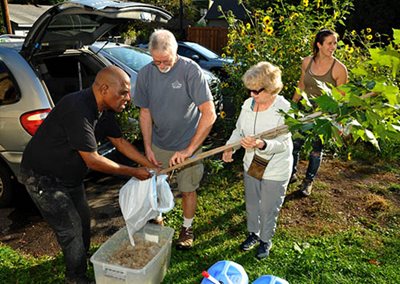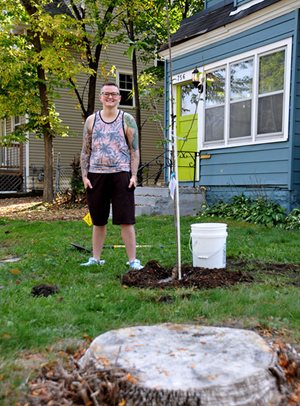 On a sunny October morning, Dave Howley stood back and admired his handiwork, a newly planted tree he had placed in the front yard of a home in Saint Paul’s historic Rondo neighborhood.
On a sunny October morning, Dave Howley stood back and admired his handiwork, a newly planted tree he had placed in the front yard of a home in Saint Paul’s historic Rondo neighborhood.
“Trees are playing the long game,” he said. “We’re playing the short game and it’s not working out for us.”
Howley was volunteering with Unity Unitarian Church and Frogtown Green, two organizations that are working to plant trees in their communities in an effort to battle climate change. This month they planted 70 new trees on private property, free of charge, in three in Saint Paul neighborhoods: Frogtown, Midway, and the historic Rondo neighborhood (now called Summit University). These areas are particularly lacking in tree cover.
On a scorching summer day, that means temperatures can be as much as 15 degrees hotter than more verdant parts of the city. The heat is spreading as the emerald ash borer infestation continues to devastate Minnesota’s tree canopy. Statewide, over a billion ash trees are at risk at a time when a changing climate is causing more extreme temperature shifts.
Collaboration is producing online tool to prioritize tree planting
It’s a problem the Metropolitan Council has been working on in partnership with the Nature Conservancy and the Tree Trust. The partners are developing an online application to help communities track where tree canopies are thin, and then prioritize where cities and communities can get the most impact from new planting.
The Growing Shade app takes data from multiple sources. Demographic information about neighborhoods, locations of businesses, schools, bus stops, parks, and other data are combined to create a complete picture of a city down to the neighborhood level. Nonprofits, cities, and communities can then take that data to target the best places to plant trees. The online tool is currently in beta testing and expected to be launched in early 2022.
 “A city could look at tree canopy through a public health lens, identifying areas where asthma rates are higher and planting trees to filter particulates out of the air,” said Eric Wojchik, planning analyst for the Met Council. “This strategy could benefit young people, targeting areas where families with younger children are living and planting trees in that area. You can look at almost any socio-economic criteria and use it to determine the best place to plant a tree.”
“A city could look at tree canopy through a public health lens, identifying areas where asthma rates are higher and planting trees to filter particulates out of the air,” said Eric Wojchik, planning analyst for the Met Council. “This strategy could benefit young people, targeting areas where families with younger children are living and planting trees in that area. You can look at almost any socio-economic criteria and use it to determine the best place to plant a tree.”
Tool can be used to address past injustices
Wojchik says treeless, hot neighborhoods can be a legacy of past racial injustices. Neighborhoods that have been historically subject to redlining and other discriminatory practices are clearly visible today if you look at the land surface temperatures on a regional heat map. Saint Paul’s Frogtown neighborhood is an area that fits that criterion. Today it has only 22% tree canopy, the lowest in the city, and it can be from 10 to 20 degrees hotter in the summer months. The ideal tree canopy coverage is 34-40%.
“When you think about it, planting trees is the ultimate form of long-range planning. It’s a commitment you’re making to allow a person to sit in the shade decades in the future,” said Wojchik. “Areas that have been historically discriminated against haven’t had people who could afford to make those investments, or, in some cases maintain the canopy, which can be costly. Growing Shade gives us a tool to help make things right.”
“It’s important to remember that when we plan for our most vulnerable residents, we are planning for everyone,” Wojchik said, “because we all have a stake in making our region more livable for everyone.”
Growing Shade app: tree canopy enhancement and preservation tool